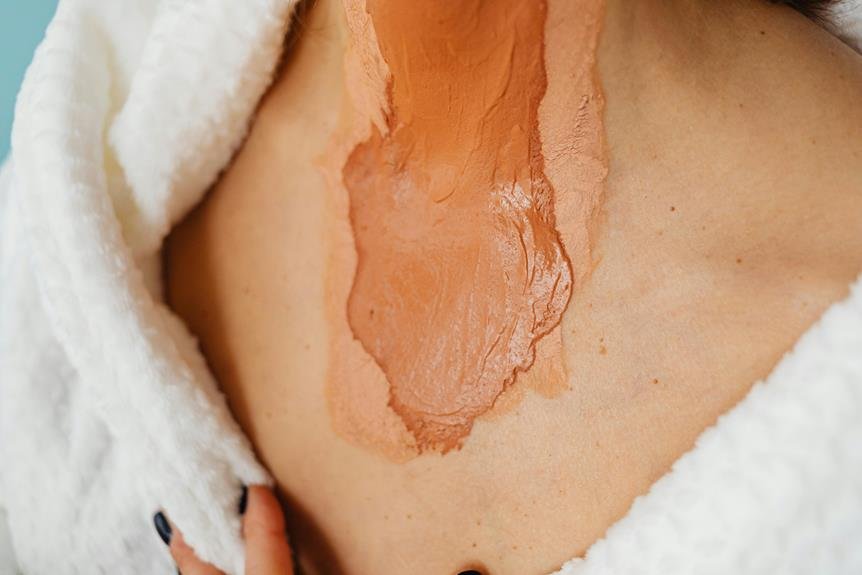
To find the perfect foundation shade for your skin tone, start by understanding your undertone. Check the veins on your wrist in natural light—if they look blue/purple, you have a cool undertone; green/olive veins indicate a warm undertone, while a mix of blue and green suggests neutral. Matching your foundation to your undertone is key for a natural finish. Next, consider your skin type—oily, dry, combination, or normal—before using online tools designed to help you find your ideal shade based on undertone, skin type, and concerns.
Finally, test the foundation on your jawline under natural light for the best match, ensuring it blends seamlessly with your neck and chest. These steps can simplify the process of choosing the perfect foundation shade.
Understanding Your Skin Undertone
To determine your skin undertone accurately, start by examining the veins on your wrist in natural light. Look at the color of your veins. If they appear more blue or purple, you likely have a cool undertone. If your veins look green or olive, your undertone is warm. Neutral undertones show a mix of blue and green in the veins.
Understanding your skin undertone is crucial when choosing the right foundation shade. For cool undertones, opt for foundations with pink or blue undertones. Those with warm undertones should go for foundations with yellow or golden undertones. If you have a neutral undertone, you can choose a foundation that falls somewhere between warm and cool tones.
Matching your foundation to your skin undertone helps create a natural and seamless look. By selecting the right undertone, you ensure that your foundation blends well with your skin, providing a flawless finish. Take the time to identify your undertone to find the perfect foundation shade that enhances your natural beauty.
Identifying Your Skin Type
When determining the right foundation for your skin tone, it's important to first identify your skin type to ensure a flawless application. Understanding your skin type will help you choose a foundation that not only matches your tone but also works well with your skin's specific needs. There are generally four common skin types: oily, dry, combination, and normal.
To identify your skin type, pay attention to how your skin feels throughout the day. Oily skin tends to have a shiny appearance and may be prone to acne. Dry skin often feels tight and can be flaky or rough. Combination skin features both oily and dry areas, usually an oily T-zone with dry cheeks. Normal skin typically feels balanced, neither too oily nor too dry.
Knowing your skin type will guide you in selecting a foundation that complements your skin's characteristics. Oily skin might benefit from oil-free or matte foundations, while dry skin may require hydrating or luminous formulas. Combination skin may do well with a foundation that provides balance. Matching your foundation to your skin type will enhance the overall look and longevity of your makeup.
Utilizing Online Foundation Matching Tools
Online tools can assist you in finding the perfect foundation shade for your skin tone with ease and accuracy. These tools typically work by asking you a series of questions about your skin, such as your undertone, skin type, and any specific concerns you may have.
Some websites even have advanced technology that allows you to upload a photo of yourself, which the tool then analyzes to suggest the most suitable foundation shades for you.
Tips for Testing and Choosing the Right Shade
When exploring the array of foundation shades recommended to you by online tools, your next step is to physically test and choose the right shade that perfectly matches your skin tone. One tip is to test the foundation on your jawline rather than your wrist or hand, as the skin on your face more closely matches your neck and chest. This will help you see how well the shade blends with your natural skin tone. Additionally, consider testing the foundation in natural light to ensure it looks seamless and matches your skin tone without any harsh lines or color discrepancies.
Another useful tip is to let the foundation set for a few minutes after applying it to see how it oxidizes and adapts to your skin. This will help you determine if the shade remains a good match or if it changes color significantly. Lastly, don't be afraid to ask for samples or swatches to take home and test in different lighting conditions before committing to a full-size product.
Conclusion
Now that you understand your skin undertone, type, and how to use online tools, finding the perfect foundation shade for your skin tone should be a breeze.
Remember to test shades on your jawline in natural light and choose one that blends seamlessly with your skin.
With these tips in mind, you'll be able to confidently rock a flawless complexion every day.




